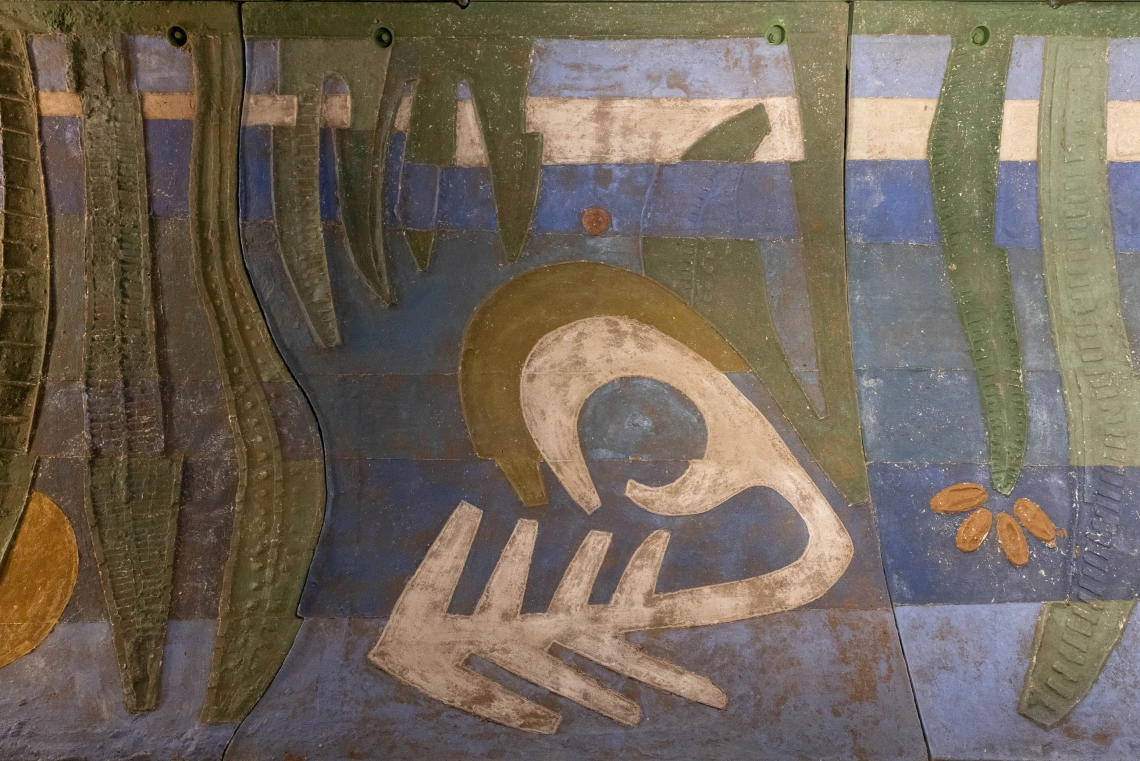Weil Center will be new home to famous installation
Paolo Soleri works at UArizona Cancer Center to be moved to new building, made accessible to the public.

The Paolo Soleri installation consists of decorative bells, 10 ceiling panels, a wall sculpture and a stained-glass window. (Courtesy Chris Richards/UA Foundation)
Update: After further discussions, the university is pausing indefinitely on this project. We want the community to know that we heard their concerns surrounding this move and appreciate the thoughtful feedback we received. Over the next few months, the university will work with preservationists to make a recommendation on where the Soleri works are best positioned, including potentially staying in place.
Works that haven’t been visible to the public for years will once again have a chance to inspire reflection in a new home at the University of Arizona Andrew Weil Center for Integrative Medicine.
The Paolo Soleri installation, commissioned by the University of Arizona in the 1980s, consists of decorative bells, 10 ceiling panels, a wall sculpture and a stained-glass window. It has been part of the UArizona Cancer Center since 1986. As the Cancer Center has grown and the building’s space repurposed from clinical to administrative space, the room housing Soleri’s chapel was closed to the public and turned into a conference room with limited access.

The installation will find a new home in the Spirit building at the University of Arizona Andrew Weil Center for Integrative Medicine.
For years, the University’s Planning Design and Construction and UArizona Health Science teams have worked to make the art accessible to the public again. It will be next year, in its new home in the Spirit building at the Andrew Weil Center for Integrative Medicine.
“We’re thrilled to provide people the opportunity to enjoy this iconic, contemplative piece,” said Andrew Weil, MD, founder and director of his namesake center.
The art will be available for public viewing after the Center opens in April 2024.
Soleri’s work is a natural fit with Weil’s multifaceted approach to wellness, which includes meditation.
“Art harnesses the power of healing as it allows the mind and body to connect,” Weil said. “It’s my sincere hope that this special space reminds people to slow down, appreciate the present and connect with those around them.”
UArizona worked closely with The Cosanti Foundation, a nonprofit founded by Soleri and his wife, Colly, focused on his concept of architecture blended with ecology and a philosophy of communities living with less. In 2018, UArizona met with Cosanti administrators, who supported the idea of reimagining the piece in a fresh space that would honor the original intent of creating a place for solace and reflection for the general public. Any parts of the original installation that aren’t used will be given to The Cosanti Foundation for preservation.

Commissioned by the University of Arizona in the 1980s, the art works have been part of the UArizona Cancer Center since 1986 but have been closed to the public for years.
Before the relocation in the spring, UArizona will document Soleri’s work in the former chapel as well as the history of the art and artist himself. The space will be preserved digitally by creating an interactive 360-degree tour, which was recommended by the Public Art Advisory Committee as one of three suggested ways the University could preserve the installation.
When it opens next year, the new Soleri installation will add yet another element to the expanding, diverse collection of art that can be seen throughout the UArizona Health Sciences campus, which includes digital, sculptural, photographic and painted pieces.
The University has a long history of preservation on the Tucson campus and other campuses around the state. The 38-acre Campus Historic District on the main Tucson campus includes a group of 21 buildings, associated landscapes, and other features listed on the National Register of Historic Places. Over the past five decades, the University has maintained a successful relationship with the Arizona State Historic Preservation Office, consulting on dozens of university preservation projects. Four of these projects have received the Annual Governor’s Heritage Preservation Honor Award, presented by the State Historic Preservation Office and Arizona Preservation Foundation, including Old Main Rehabilitation, Herring Hall Rehabilitation, Cannon-Douglass House Rehabilitation, and Phoenix Union High School Adaptive Reuse.
In a statement about the move, the university said: “The University is proud of its stewardship role in the preservation of historic and cultural resources on the main campus and other University properties across Arizona. We look forward to continuing our important and recognized historic preservation efforts.”

